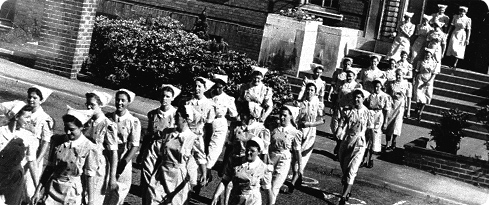Your views

Your feedback is vital to us as we continue to increase the quality of our services.
You are here:
Date: 20 December 2024
Time: 15:23
The first years under the National Health Service
Under the new National Health Services Act (1946), the Birmingham teaching hospitals were considered to be a single hospital, named the Birmingham United Hospital (BUH).
Its Board of Governors included 30 members, who were drawn from the staff of the university, Regional Hospital Board and the teaching hospitals. In contrast to earlier times, when female representation was non-existent, one sixth of its members were women. A photograph of nurses leaving Nuffield House to start work is pictured below.

At the Board’s first meeting on 18 June 1948, its members drew attention to their "noble heritage", namely the individual hospitals which had for so many decades provided medical services to the inhabitants of Birmingham and the region. At this time, besides the QE, these included the General Hospital, Queen’s Hospital, Women’s Hospital, Maternity Hospital, Children’s Hospital, Birmingham Dental Hospital and the Midland Nerve Hospital.
The annual expenditure of the BUH surpassed £1 million, of which the QE accounted for the most (£394,000) and the Midland Nerve Hospital the least (£19,000).
Responsible for the greatest single expenditure, the QE also treated the most patients, accounting for nearly a third of the BUH’s 29,000 patients. Of all 11,000 patients treated in 1949, the majority, as in the past, were medical (26%) and surgical (34%) cases. However, many more were being treated by practitioners in the emerging fields of neurology (5.5%), neurosurgery (3.6%) and plastic surgery (0.2%).
The remainder sought treatment from practitioners of older specialties, including ophthalmology, obstetrics, gynaecology, ENT and dermatology, services which were still offered at local specialist hospitals. More specifically, the main diagnoses among the QE’s male inpatients were cancer (17%), tuberculosis (4.3%), varicose veins (3.6%) and hernia (3.2%).
Among women, the most common diagnoses were cancer (13%), diseases of the thyroid (5.5%), tuberculosis (4%) and varicose veins and appendicitis, both accounting for 3% of female cases.
These disease patterns were evident to local doctors and Government officials in earlier years. As early as 1945, the Government encouraged and approved the establishment of a Birmingham Cancer Unit, for which 65 beds in an old administrative block of the hospital and £46,000 had been set aside.
The project would transform the QE into the regional centre for cancer treatment and research, as is reflected in patient statistics in these and later years. The unit’s close links with the University’s Department of Medical Statistics were just some of the collaborations that hospital governors had foreseen by situating the hospital, Medical School and university more closely together. Nurses' education at the Queen Elizabeth Hospital is shown in the photograph below.

Unlike the other seven BUH hospitals, the QE received most of its patients from an expanding waiting list (73.4%) and referrals from GPs (14%), rather than the outpatient department and casualties (3.4%), a route that on average accounted for 30% of admissions at the other local hospitals that made up the BUH.
The majority of the QE’s patients (70%) came from Warwickshire, but significant percentages also came from Staffordshire (14%) and Worcestershire (12%).
The increase in the QE’s workload necessitated additional accommodation for staff. An estimated 57 new rooms for nurses were required in the immediate post-war period. Most of these would be situated at a house at 40 Edgbaston Park Road, which was donated by Mr Barrow Cadbury and transferred to the Preliminary Training School for nurses.
The pressure on staff, however, did not let up in these years. As a result, the QE School of Nursing was started in the 1950s to provide additional trained nurses to all BUH institutions.
Costs at the QE had escalated to £2.2 million by the mid-1950s. The majority of this was going towards salaries and wages (72%). Other significant costs were provisions (11%), fuel, power and water (7%), medical and surgical supplies (5%), and drugs and dressings (4%).
Related pages

Getting here
Information about travelling to, staying at and getting around the hospital.

Jobs at UHB
A great place to work. Learn why.


